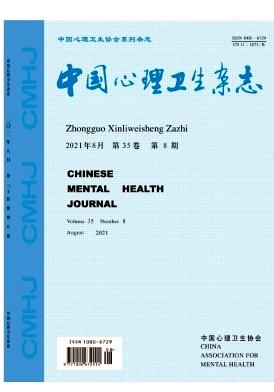Mental health service demands among medical staff during the COVID-19 epidemic.
引用次数: 1
Abstract
Objective: To explore the mental health service demands among medical staff and its distributions during the COVID-19 epidemic, so as to provide basis for psychological interventions. Methods: A total of 4677 medical staff from 348 hospitals in 31 provinces of China were investigated by an online survey based on "questionnaire star" from February 17 to 24, 2020. A self-designed questionnaire was used to collection information of social-demographic characteristics and mental health service demands. Psychological problem was defined if the screening results of any of the following instruments were positive, including Self Report Questionnaire for emotional pain, Self-rating Anxiety Scale for anxiety symptoms, and Self-rating Depression Scale for depression symptoms. Mental health service demands were recorded according to the self-report of the respondents. Results: Prevalence of psychological problem was 39. 3% and the demands of mental health services among medical staff with any psychological problem was 27. 2%. The results of multivariate analysis showed that fewer instruments with positive screening results ( only one instrument, OR = 3. 02, 95% CI: 2.35 — 3. 89, two instruments, OR = 1. 65, 95% CI: 1.26 — 2. 16), aged 29 and less ( OR = 1. 66, 95% CI: 1. 01 — 2.74), working in departments with lower risk ( OR = 1. 28, 95% CI: 1. 003 — 1. 64), and no epidemic isolation from themselves or the people around them ( OR = 1. 54, 95% CI: 1. 09 —2. 18) were associated with less mental health service demands. There were significant differences among the intentions to the provided methods of mental health services among medical staff with different types of screening results. Promoting health knowledge by mobile phone was the top intention in each subgroup. Conclusion: The rate of mental health service demands for medical staff with psychological problems is relatively low during the COVID-19 epidemic. Different intervention methods should be used for different populations during the psychological interventions. (English) [ABSTRACT FROM AUTHOR] 目的:了解新冠肺炎流行期间医护人员心理卫生服务需求及分布特点,为开展心理干预工作 提供依据。方法:2020年 2月 17日 -24日,采用 “问卷星”进行网络调查,中国 31个省份 348家医院共 4677名医护人员参与;采用自行设计问卷调查一般人口学特征、医护人员的心理需求及相关因素,采用心 理健康自评问卷 (SRQ-20)评估情感痛苦,焦虑自评量表评估焦虑症状,抑郁自评量表评估抑郁症状,并 将有心理问题定义为上述 3个量表中任意一个量表筛查阳性。采用自我报告的方式记录心理卫生服务需求。 结果:心理问题的检出率为 39.3%。有心理问题者的心理卫生服务需求率为 27.2%。多因素分析结果显 示,筛查阳性量表数目少 (任意 1种,OR = 3. 02, 95% CI: 2.35 ~ 3. 89 任意 2种,OR = 1. 65, 95% CI: 1.26 ~ 2. 16),年龄在 29岁及以下 (OR = 1. 66, 95% CI: 1. 01 ~ 2.74),在低风险科室工作 (OR = 1. 28, 95% CI: 1. 003 ~ 1. 64),及自己或周围无人被隔离 (OR = 1. 54, 95% CI: 1. 09 ~ 2. 18)与心理卫生服务需 求率低有关。不同类别的筛查阳性者心理卫生服务方式的选择意愿存在差异,其中以接受手机推送方式的 心理干预比例最高。结论:新冠肺炎流行期间存在心理问题医护人员接受心理卫生服务需求比例不高,在 具体干预工作中针对不同人群应当采取不同干预方式。 (Chinese) [ABSTRACT FROM AUTHOR] Copyright of Chinese Mental Health Journal / Zhongguo Xinli Weisheng Zazhi is the property of Chinese Mental Health Journal and its content may not be copied or emailed to multiple sites or posted to a listserv without the copyright holder's express written permission. However, users may print, download, or email articles for individual use. This abstract may be abridged. No warranty is given about the accuracy of the copy. Users should refer to the original published version of the material for the full abstract. (Copyright applies to all Abstracts.)新冠肺炎疫情期间医务人员心理卫生服务需求
目的:了解新冠肺炎疫情期间医务人员心理健康服务需求及其分布情况,为心理干预提供依据。方法:于2020年2月17日至24日,采用“问卷之星”在线调查方式,对全国31个省份348家医院的4677名医务人员进行调查。采用自行设计的问卷收集社会人口学特征和心理卫生服务需求信息。如果以下任何一项工具的筛查结果为阳性,则定义为心理问题,包括情绪痛苦自我报告问卷,焦虑症状自评焦虑量表和抑郁症状自评抑郁量表。根据被调查者的自述记录心理卫生服务需求。结果:心理问题患病率为39。有心理问题的医务人员中有心理健康服务需求的占27%。2%. 多因素分析结果显示,筛查阳性的器械较少(仅有1台器械,OR = 3)。02, 95% ci: 2.35 - 3。89、两个仪器,OR = 1。65, 95% ci: 1.26 - 2。16),年龄在29岁及以下(OR = 1)。66, 95% ci: 1。01 - 2.74),在低风险部门工作(OR = 1)。28, 95% ci: 1。003 - 1。64),无疫情隔离(or = 1)。54, 95% ci: 1。09年2。18)与较少的心理健康服务需求相关。不同类型筛查结果的医务人员对心理健康服务提供方式的意向存在显著差异。通过手机宣传健康知识是每个亚组的首要意图。结论:新冠肺炎疫情期间,有心理问题医务人员心理卫生服务需求比例较低。心理干预应针对不同人群采取不同的干预方法。从作者(英文)[摘要]目的:了解新冠肺炎流行期间医护人员心理卫生服务需求及分布特点,为开展心理干预工作提供依据。方法:2020年2月17日-24日,采用“问卷星”进行网络调查,中国31个省348份家医院共4677名医护人员参与,采用自行设计问卷调查一般人口学特征,医护人员的心理需求及相关因素,采用心理健康自评问卷(世界)评估情感痛苦,焦虑自评量表评估焦虑症状,抑郁自评量表评估抑郁症状,并将有心理问题定义为上述三个量表中任意一个量表筛查阳性。采用自我报告的方式记录心理卫生服务需求。 这句话的意思是:27.2%。1、或= 3、0、0、0、0、0、002, 95% ci: 2.35 ~ 3。89 .或= 1。65, 95% ci: 1.26 ~ 2。16)、(或= 1)、(或= 1)。66, 95% ci: 1。01 ~ 2.74), (or = 1)。28, 95% ci: 1。003 ~ 1。(或= 1)。54, 95% ci: 1。09 ~ 2。18)与心理卫生服务需 求率低有关。不同类别的筛查阳性者心理卫生服务方式的选择意愿存在差异,其中以接受手机推送方式的 心理干预比例最高。结论:新冠肺炎流行期间存在心理问题医护人员接受心理卫生服务需求比例不高,在 具体干预工作中针对不同人群应当采取不同干预方式。 《中国精神卫生杂志》版权所有,未经著作权人明确书面许可,其内容不得复制、电邮至多个网站或在列表中发布。但是,用户可以打印、下载或通过电子邮件发送文章供个人使用。这篇摘要可以删节。对副本的准确性不作任何保证。用户应参考资料的原始出版版本以获取完整摘要。(版权适用于所有摘要。)
本文章由计算机程序翻译,如有差异,请以英文原文为准。
求助全文
约1分钟内获得全文
求助全文
来源期刊
自引率
0.00%
发文量
7602
期刊介绍:
Chinese Mental Health Journal is a national level academic journal in the field of psychology, approved by the State Administration of Press and Publication, supervised by the China Association for Science and Technology, and sponsored by the China Mental Health Association. The establishment of the Chinese Journal of Mental Health was in 1987, with a monthly publication cycle. The domestic unified serial number of the journal is 11-1873/R, and the international standard serial number is 1000-6729.
Literature database inclusion status:
Overview of Chinese Core Journals (Peking University Library, etc.).
China Science Citation Database (Core Database) (CSCD) (National Science Library of the Chinese Academy of Sciences).
China Science and Technology Paper and Citation Database (CSTPCD) (China Institute of Science and Technology Information).
Outline of Core Journals of Chinese Humanities and Social Sciences (CASS) (Chinese Academy of Social Sciences).
The important reprint source journals of "copying newspapers and periodicals" (Research Center for Evaluation of Academic Achievements of Humanities and Social Sciences, Renmin University of China, etc.).
Chinese Social Science Citation Index (CSSCI) (China Social Science Research Evaluation Center, Nanjing University).
Chinese Biomedical Journal Citation Database (CMCI), Chinese Biomedical Literature Database Online (CBMDISC), Chinese Biomedical Journal Literature Database (CMCC), Chinese Academic Journal Abstracts, Chinese Science and Technology Data Catalog, etc.
Ulrich's Periodic Directory in the United States.
JST Japan Science and Technology Agency Database (Japan) (2018).
The full text electronic version is authorized to be included in the China Journal Full Text Special Database (CNKI), Wanfang Data, China Science and Technology Journal Database (VIP Full Text Electronic Journal), and EBSCO Literature Database in the United States.

 求助内容:
求助内容: 应助结果提醒方式:
应助结果提醒方式:


